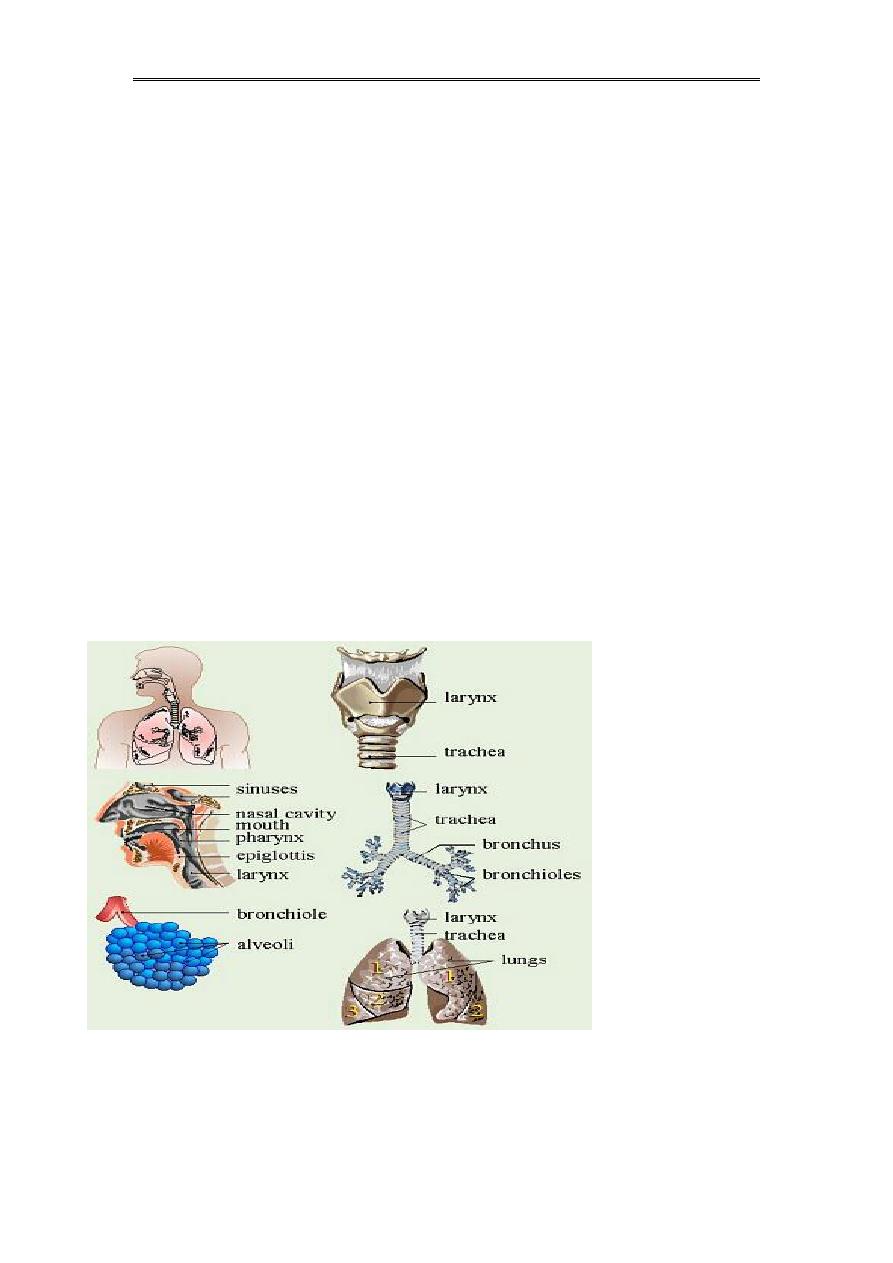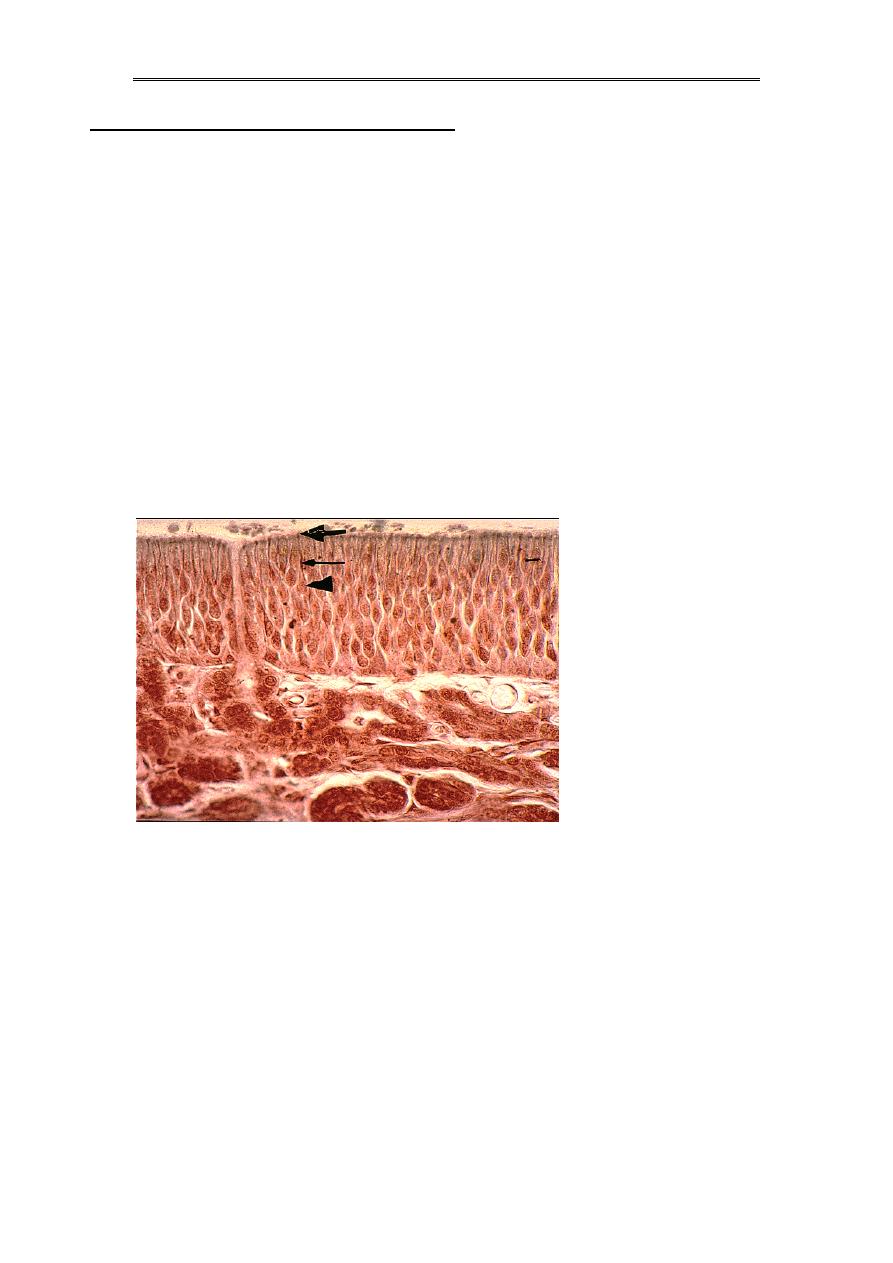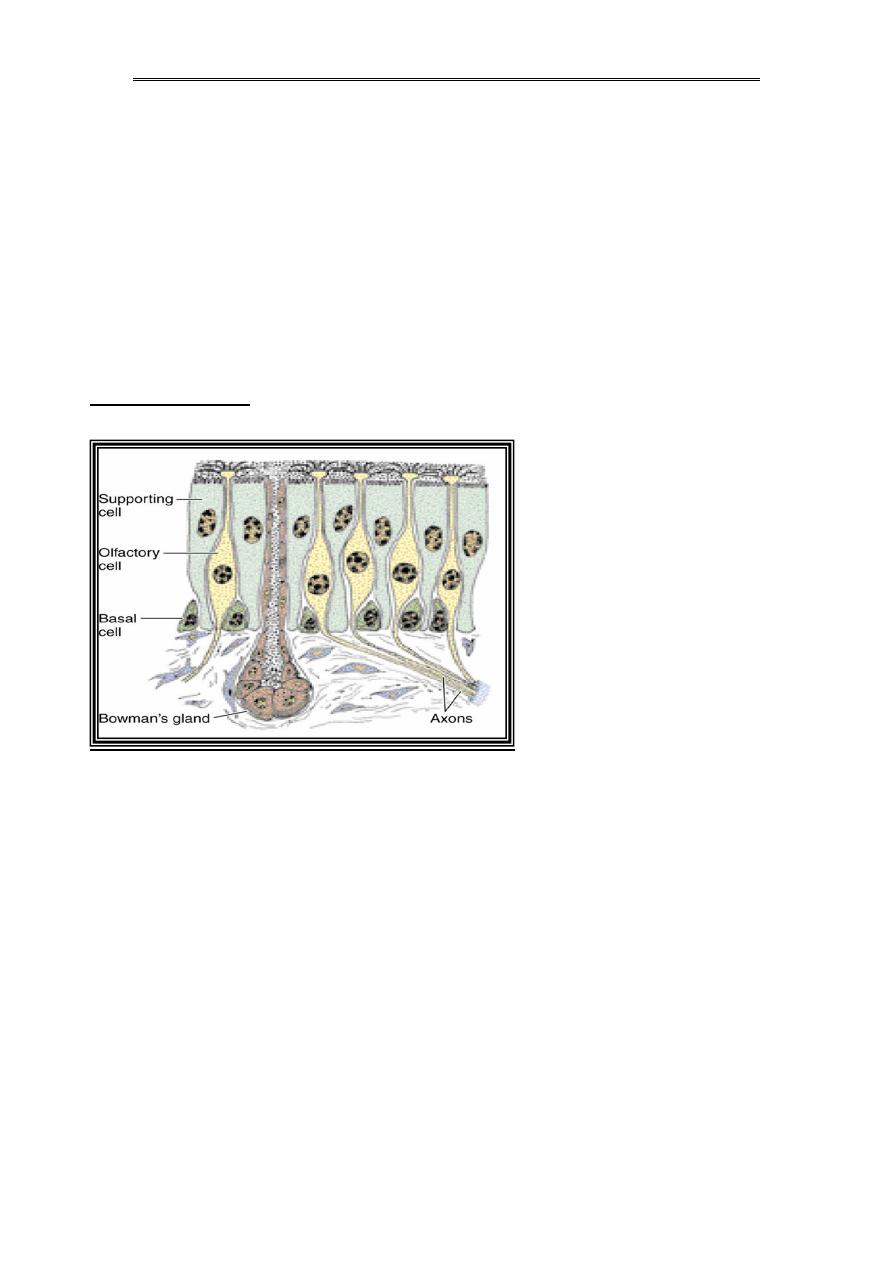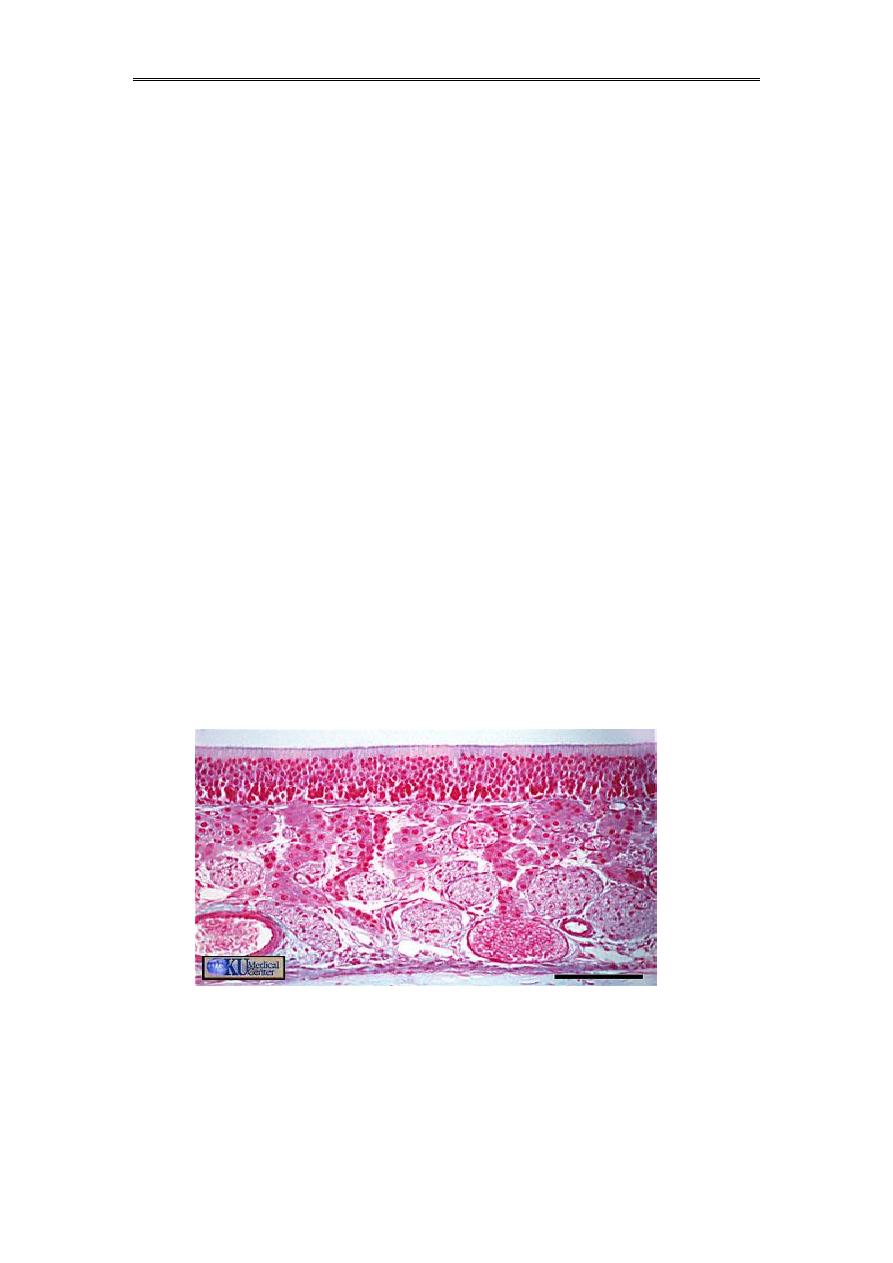
The Respiratory System د.رند عبد اللطيف
Lecture 1
1
The Respiratory System
Is the complex of organs and tissues which are necessary to exchange
blood carbon dioxide (CO
2
) with air oxygen (O
2
). It consists typically of
pharynx, larynx, bronchi, lungs and diaphragm.
1. Conducting portion (upper respiratory tract): formed of a series of transport
passages by which air pass from the atmosphere to the lung. It consist of (nasal
cavity, nasopharynx, larynx, trachea, bronchi, bronchioles & terminal
bronchioles).
2. Respiratory portion (lower respiratory system): which is responsible for
gaseous exchange consist of (respiratory bronchioles, alveolar ducts & alveoli).
The alveoli are specialized sac like structures forming the greater part of the
lung & they are the main sites for exchange of O2 & CO2 between the air &
the blood.

The Respiratory System د.رند عبد اللطيف
Lecture 1
2
The conducting portion of the respiratory system has many functions:
1. It is a system of channels through which air will reach the lungs and to
ensure adequate & continuous supply of air to both lungs a combination of
cartilages, elastic fibers, collagen fibers & smooth muscle fibers provides the
conducting part with rigid structural support and with the necessary flexibility
and extendibility.
2. While passing through the conducting part the air will be cleaned (by
removal of foreign particles), moistened & warmed, to carry out these
functions, the mucosa of the conducting part is lined with a specialized
epithelium called respiratory epithelium.
3. In addition the proximal part of the respiratory tract has a specialized
structures that are involved in the perception of smell & flavor (Olfactory
mucosa) & the production of sound (Larynx).
Cartilages in the respiratory system:
Cartilages are mainly hyaline in type, they have various forms ranging from
small plaques in the bronchi to irregular rings & in the trachea C-shaped
cartilages. The cartilages generally produce support to the wall of the
conducting part to prevent collapse of the lumen during expiration & to ensure
continuous air entry to the lungs.
Elasic fibers in the respiratory system:
found in both conducting and respiratory parts to provide these areas with
flexibility and to allow them to return to their original shape after
inspiration.The concentration of elastic fibers is inversely proportionate to the
diameter of the conducting tubule (ie. the smallest bronchioles have the highest
amount of elastic fibers in their lamina propria).

The Respiratory System د.رند عبد اللطيف
Lecture 1
3
Smooth muscles in the respiratory system:
bundles of smooth muscles encircle the tube from the trachea to the alveolar
ducts. Contraction of those smooth muscles reduces the diameter of the
conducting tubules to regulate the air flow during inspiration and expiration.
The conducting part of the respiratory system gradually undergoes transition
into the respiratory part. The ciliated epithelium, goblet cells & cartilages
will gradually decrease in the wall of the system while the content of smooth
muscles & elastic fibers gradually increase.
Respiratory Epithelium:
Most of the conducting portion of the respiratory system is lined with
pseudostratified ciliated columnar epithelium that contains large number of
mucous secreting cells called goblet cells. As the bronchi subdivide into
bronchioles some structural changes occure are:
pseudostratified epithelium will change to simple columnar epithelium
which is further reduced to simple cuboidal epithelium in the terminal
bronchioles.

The Respiratory System د.رند عبد اللطيف
Lecture 1
4
goblet cells gradually decrease in number in the smaller bronchi & are
completely absent from the epithelium in the terminal bronchioles.
ciliated cells still present in the terminal bronchioles without the goblet
cells in order to prevent accumulation of mucous in the respiratory
portion of the system because the cilia help to move this mucous upward
toward the mouth where it is either swallowed or expectorated.
Typical respiratory epithelium: consists of five cell types:
1. Ciliated columnar cells: most numerous type of cells, each cell has about
300 cilia in its apical surface, sometimes defective functioning of the cilia
is present leading to immotile cilia syndrome (due to deficiency of the
protein Dynein) this will lead to increased incidence of respiratory
infections. Ciliated columnar cells become shorter with successive
branching of the bronchial tree until they become cuboidal in the most
peripheral branches.
2. Mucous secreting goblet cells: the second most numerous type of cells,
they are scattered in between the ciliated columnar cells, their cytoplasm is
filled with mucous droplets and their number gradually decrease until they
are absent in the terminal bronchioles, they increase in some chronic
respiratory diseases.
3. Basal cells: small rounded cells lie on the basement membrane, they are
not in contact with the lumen, and they form stem cells from which other
cell types develop.
4. Brush cells: columnar cells with many microvilli on their apical surface,
they have afferent nerve endings on their basal surface & are considered to
be sensory receptors.

The Respiratory System د.رند عبد اللطيف
Lecture 1
5
5. Neuroendocrine cells: small rounded cells with dark nuclei & cytoplasm
filled with endocrine granules that regulate the interaction between mucous
and serous secretory functions of the system.
In smokers the proportion of ciliated cells to goblet cells is altered so greater
number of goblet cells are found to aid in clearing the increased amount of
particulates & gaseous pollutants in their respiratory epithelium, while the
reduction in ciliated cells caused by excessive intake of CO resulting in
decreased movement of the mucous layer leading to congestion of the
smoker’s airways.
Nasal Cavity:
The Nasal cavity is divided into three structurally and functionally different
parts.
1. Vestibule: is the most anterior dilated part of the nasal cavity forming the
first ~1.5 cm of the conductive portion following the nostrils which are lined
with a keratinized stratified squamous epithelium, numerous sebaceous glands
& thick short hairs, within the vestibule the epithelium loses its keratinization
and undergoes gradual transition into typical respiratory epithelium.
2. Respiratory region: at the transition from the vestibule to the respiratory
region of the nasal cavity the epithelium becomes first non keratinized
stratified squamous and then pseudostratified ciliated columnar with goblet
cells (respiratory epithelium). The surface of the lateral parts of the nasal
cavity is thrown into folds by bony projections called conchae. These folds
increase the surface area of the nasal cavity and they create a turbulence in the
stream of the passing air, both functions will facilitate the conditioning
(warming, moistening and filtration) of the air. The lamina propria contains
mucous and serous glands which supplement the secretions of the goblet cells

The Respiratory System د.رند عبد اللطيف
Lecture 1
6
with a large venous plexuses known as swell bodies, they are important for
conditioning of air thus abnormal enlargement of swell bodies with blood
occurs in allergic reaction & inflammation so they restrict air flow to the air
passages.
3. Olfactory region formed by tissues on the superior concha and the nasal
septum of the nasal cavity, it is lined with a special type of epithelium called
Olfactory mucosa.
Olfactory mucosa:
Is a special type of mucosa, located in the roof of the nasal cavity & extend for
a short distance down the septum and lateral wall it is responsible for the
sensation of smell & the more sophisticated epithelium aspect of taste. The
Olfactory mucosa has a pseudostratified columnar epithelium that is composed
of three types of cells which are:
1. Basal cells: are small cone shape cells rest on the basement membrane not
in contact with the lumen their nuclei are close to the basement membrane,
these cells are regarded as the stem cells from which new olfactory cells can
develop.

The Respiratory System د.رند عبد اللطيف
Lecture 1
7
2. Sustentacular cells (supporting cells): are tall cells their nuclei are
closest to the lumen & they have a narrow base in contact with the basement
membrane & microvilli on their free surface, they give mechanical &
metabolic support to the basal & olfactory cells.
3. Olfactory receptor cells: are bipolar neurons found in between the basal
& sustentacular cells they have a central bulge contain the nucleus & from the
cell extend 2 processes:
a) Dendritic process: extend to the surface epithelium where its tip
expand into a club-shaped prominence called Olfactory vesicle which
bears cilia that protrude into the nasal cavity these cilia are sensitive
to odorous substances.
b) Proximal process: very narrow & pass between the basal &
sustentacular cells to penetrate the basement membrane & join the
other proximal processes of other cells to form what is called fila
olfactoria which will then form a synaptic connection with the
olfactory bulb to form the first cranial nerve (Olfactory nerve).
Beneath the epithelium of the olfactory mucosa the connective tissue of the
lamina propria contain small serous glands called Bowman's glands their
secretion may act as a solvent for the odorous substances, this connective
tissue is highly vascular and contain the fila olfactoria.

The Respiratory System د.رند عبد اللطيف
Lecture 1
8
Pharynx:
The pharynx connects the nasal cavity with the larynx. Depending on the
extent of abrasive forces on the epithelium, the pharynx is either lined with
respiratory epithelium (nasopharynx) or with a stratified squamous epithelium
(oropharynx) which also covers the surfaces of the oral cavity and the
oesophagus.Lymphocytes frequently accumulate beneath the epithelium of the
pharynx.Accumulations of lymphoid tissues surrounding the openings of the
digestive and respiratory passages form the
Larynx:
The larynx connects the pharynx and trachea. The vocal folds of the larynx
control airflow and allow the production of sound. The vocal folds are lined by
stratified squamous epithelium and contain the muscle (striated, skeletal) and
ligaments needed to control the tension of the vocal folds.
